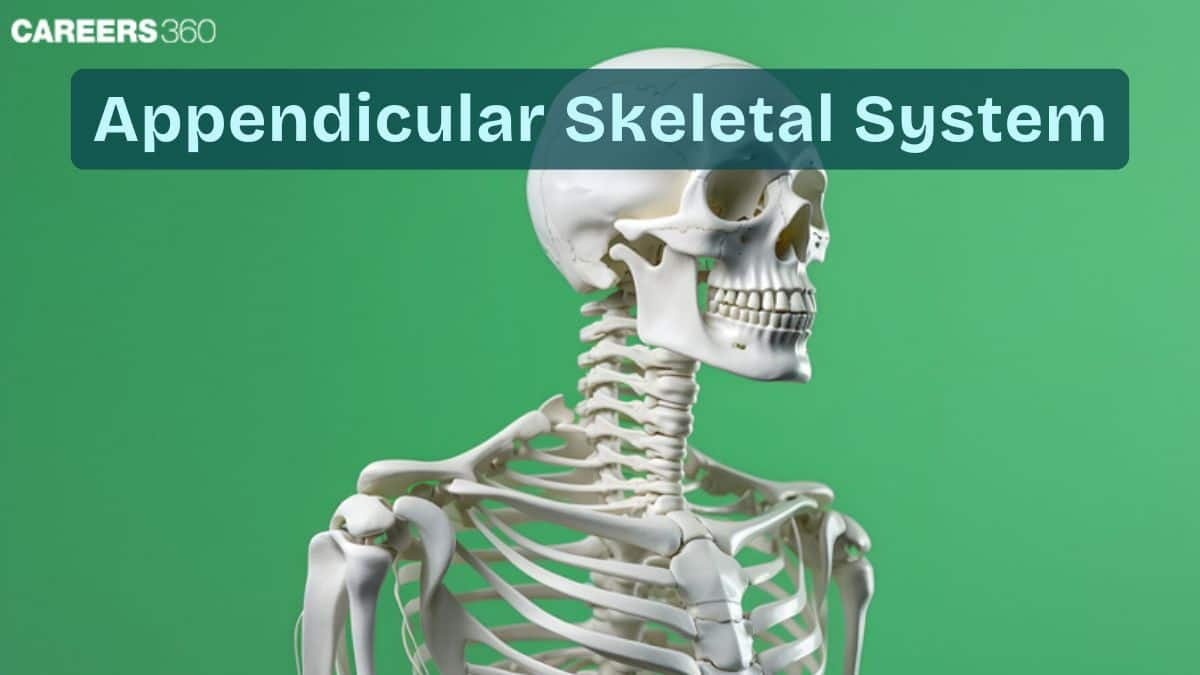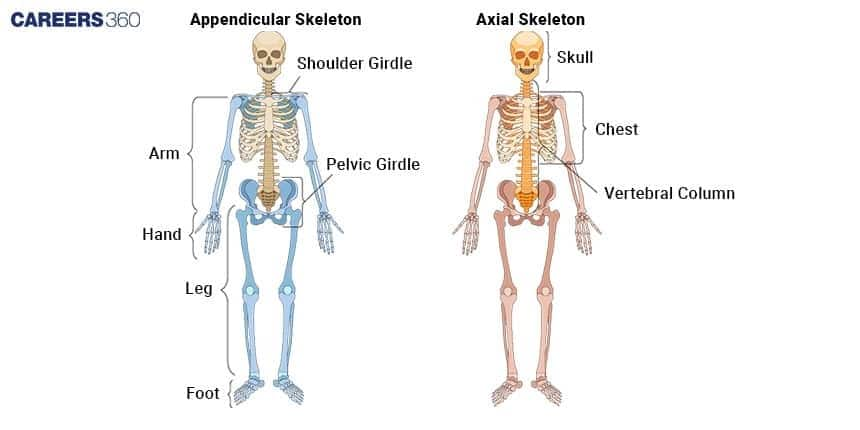Appendicular Skeleton System: Definition, Function, Anatomy
The appendicular skeleton consists of the upper and lower limbs along with their girdles and is primarily responsible for movement and locomotion. It includes 126 bones that provide flexibility, balance, and the ability to perform daily activities such as walking, lifting, and grasping. This guide covers the structure, components, limb bones, functions, diagrams, FAQs, and NEET-oriented MCQs.
This Story also Contains
- What Is The Appendicular Skeleton System?
- Structure Of The Appendicular Skeleton
- Upper Limb Bones
- Lower Limb Bones
- Functions of the Appendicular Skeleton
- Appendicular Skeleton vs Axial Skeleton
- Appendicular Skeletal System NEET MCQs (With Answers & Explanations)

What Is The Appendicular Skeleton System?
The overall functions of the human skeletal system are to provide structure, and protection to organs and to act as a means of motion. The skeleton is mainly divided into the appendicular skeleton and axial skeleton. The axial system forms the central portion of the framework of the body. The primary function of the appendicular skeleton is movement.
The appendicular skeleton includes the bones that make up the upper and lower limbs as well as the bones of the two girdles that attach the limbs to the axial skeleton. The bones of the appendicular skeleton are connected with one another and with skeletal muscles, permitting you to do things such as walk, write, swim and dance.

Structure Of The Appendicular Skeleton
The appendicular skeleton includes the upper and lower limbs with their girdles. It is composed of 126 bones that render mobility and dexterity to the body in accomplishing normal daily activities.
Upper Limb Bones
The upper limb bones are listed below-
Pectoral Girdle (Shoulder Bones)
The pectoral girdle is formed by the clavicle and scapula, which attach the upper limbs to the trunk and support the movements of the arm.
Bones of the Arm and Forearm
The humerus, radius, and ulna are bones in the arm and forearm that supply a basis for a wide range of motion, which includes flexion and rotation of the forearm.
Bones of the Hand
Carpal and metacarpal bones, along with phalanges or finger bones, compose the framework and agility for grasping and manipulating food.
Lower Limb Bones
The lower limb bones are listed below-
Pelvic Girdle
The hip bones are called the ilium, ischium, and pubis, and the sacrum makes for the pelvic girdle. This structure supports the weight of the body and connects or attaches the lower limbs to the axial skeleton.
Bones of the Thigh and Leg
The femur or the thigh bone, patella or the kneecap, and the tibia and fibula are the underlying bones for motion and weight-bearing activities of the thigh and leg.
Bones of the Foot
Tarsals, metatarsals, and phalanges are the stabilizing, balancing, and propelling structures of walking and running.
Functions of the Appendicular Skeleton
The main function of the appendicular skeleton is:
Movement
It enables locomotion and allows limb movement in the human body.
Muscle Attachment
It also provides attachment to muscles that aid a person to move his or her hands, arms, feet, and legs inconspicuously subordinate to unconscious activity. It works with skeletal muscles.
Weight Bearing and Balance
Of very significant importance, the appendicular skeleton supports an individual's body weight as well as maintains balance and posture.
Appendicular Skeleton vs Axial Skeleton
The difference between axial skeleton and appendicular skeleton is discussed in the table below:
Features | Appendicular Skeleton | Axial Skeleton |
Main components | Limbs and girdles | Skull, vertebral column, ribs, sternum |
Number of bones | 126 bones | 80 bones |
Function | Enables movement and locomotion | Supports and protects vital organs |
Type of movements | Wide range of movements | Limited movement |
Location | Attached to axial skeleton | Forms central axis of the body |
Appendicular Skeletal System NEET MCQs (With Answers & Explanations)
Important questions asked in NEET from this topic are:
Components of appendicular skeletal system
Appendicular vs Axial skeletal system
Practice Questions for NEET
Q1. The collar bone is also known as
Pollex
Phalanges
Clavicle
Scapula
Correct answer: 3) Clavicle.
Explanation:
The clavicle is another name for the collarbone. Between the scapula (shoulder blade) and the sternum (breastbone), this long, S-shaped bone acts as a strut. The clavicle permits the arm's complete range of motion and aids in shoulder stabilization. Because of its location and role in supporting the shoulder joint, it is one of the most often fractured bones in the body.
Hence, the correct answer is option 3) Clavicle.
Q2. The scapula is a large triangular flat bone situated in the dorsal part of the thorax between
Second and seventh rib
Third and fourth rib
Fifth and sixth rib
Second and fifth rib
Correct answer: 1) Second and seventh rib
Explanation:
The scapula, also known as the shoulder blade, is a large, triangular, flat bone situated in the dorsal part of the thorax, typically between the second and seventh ribs. It forms a part of the pectoral girdle, connecting the upper limb to the trunk. The scapula has several important features, including the spine, which divides the posterior surface into two regions, and the acromion, a bony prominence that forms the highest point of the shoulder. It also has the coracoid process, which serves as an attachment point for muscles and ligaments. The glenoid cavity is a shallow depression where the humerus (upper arm bone) articulates with the scapula, forming the shoulder joint. The scapula provides attachment for muscles involved in arm movement, such as the deltoid, supraspinatus, infraspinatus, and others. Its mobility and structure are essential for a wide range of shoulder movements, including raising the arm, rotation, and lifting.
Hence, the correct answer is option 1) Second and seventh rib.
Q3. The large, flat, triangular bone present in two halves of the pectoral girdle is
Scapula
UIna
Clavicle
Radius
Correct answer: 1) Scapula
Explanation:
The pectoral girdle is made of two bones. These are the clavicle and the scapula. The scapula is the large triangular flat bone located on the dorsal aspect of the thorax between the second and seventh ribs. A ridge known as the spine gives off to the acromion. The clavicle articulates with the acromion and is termed the collarbone. The glenoid cavity lying beneath the acromion forms the shoulder joint by articulating with the humerus.
Hence, the correct answer is option 1) Scapula.
Also Read:
Frequently Asked Questions (FAQs)
Appendicular Skeleton: The appendicular skeleton is constituted by the bones of the limbs and their connecting girdles, namely the pectoral and pelvic. It enables movement while at the same time supporting the body weight.
The appendicular skeleton is related to the motion and anchoring of muscles controlling the arms, hands, legs, and feet.
The appendicular skeleton involved in everyday activities is from easy simple writing on a board or walking to very complex gymnastics and various sports and dance forms, proving their vital role in the activities of daily life.
Injuries sometimes result in fractures, dislocations, and sprains that often need some form of medical intervention to return to function and mobility.